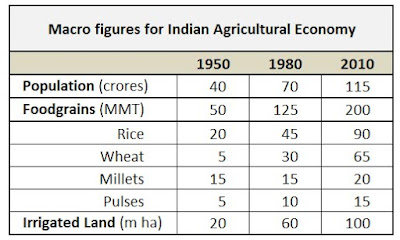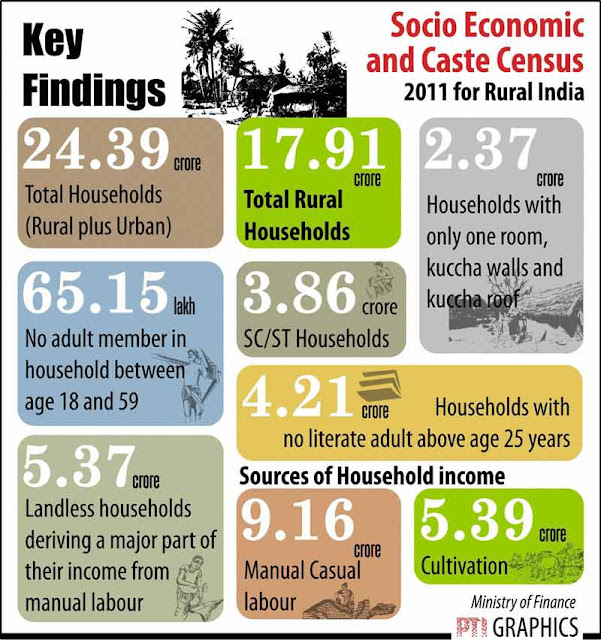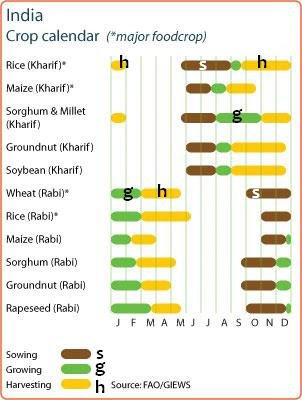A world leader in production, consumption & exports, Indian agriculture faces unique challenges.
India has largely remained an agricultural economy. But it is a very complex system, with multiple overlapping legal provisions, social compulsions and technological impediments. The problems of Indian agricultural economy are complex because many are not easily visible, and solutions to these is not easy to find. Among the chief paradox of Indian agriculture is the fact that while we say that more than 65 per cent of our population is in agriculture, a large portion of it is under-employed, or they are disguisedly employed as they have no other alternative source of employment.
Although India has the world’s second largest agricultural land, but most of it is fragmented and broken into unviable small farmlands, and hence the productivity is hopelessly low. This is because of the huge population growth (and size), and fragmentation with each new generation coming in. Most of the agriculture is subsistence. The share in the country’s GDP is only about 16%. Further, more than 60 per cent of this land is un-irrigated. Our agriculture is still rain-fed, that accounts for tragic stories in years the monsoon fails.
[Read this Bodhi in Hindi, here]
[Read this Bodhi in Hindi, here]
India simultaneously boasts being the largest producer of many major agro-products in the world, like pulses, milk and milk products, fruits and vegetables. But even here, there is no denying the fact that low productivity is the norm. We may be the highest producers of milk and milk products globally, but the our productivity in this sector is one of the lowest, and we come nowhere near the top five countries. We are the highest producers of pulses in the world, but yet we have to import pulses in large quantities year after year. There are strong and compelling reasons to do so, however.
[ Running updates - Current Affairs, here]
Our foodgrain godowns are at times overflowing with stocks, but a large number of our citizens are forced to sleep without two square meals per day. This was pointed out by the Courts too. The Food Corporation of India (FCI) and its associates run a large machine, which at times just sputters.
On the malnutrition index, unfortunately we are at the bottom of the heap. Agricultural employment is not only unorganised but also subject to systemic exploitation by money-lenders, mafia and local politicians. Thousands of farmers are forced to commit suicide every year, though many do it out of personal reasons as well.
Taken in totality, the above signs do not reflect a healthy agricultural economy ready to meet the challenges of a growing population. When making policies for agriculture, we should first find solutions to the above problems and complexities to make Indian agriculture self-sustaining and profitable. The Modi government has committed itself to double the farm income by 2022.
[इस बोधि को हिंदी में पढ़ें, यहाँ]
[इस बोधि को हिंदी में पढ़ें, यहाँ]
It looks like a very difficult task, but not impossible to achieve. While striving to achieve it, the government also needs to address the above important issues in a thorough, transparent and systemic manner. The launch of electronic National Agriculture Market (eNAM) is one step in that direction. More initiatives like national cold storage chain, food parks and processing clusters, modern irrigation methods like drip irrigation etc. are needed on a larger scale now.
Amazing Courses - Online and Classroom :
Doubling farm incomes by 2022
India's Agriculture GDP = Crops + Forestry + Fisheries. While crops are 60% of this GDP, the horticulture sector is 30% of crops. Contrary to popular perception, farmers are not united politically across the nation. Many experts allege that governments utilise this lack of political voice in many ways, not the least being the exploitation of their concerns to garner votes while denying real opportunities for lasting change. Here is a complete explanation of the multiple related issues.
And there's a whole report on this issue, from Indian Council of Food and Agriculture which you can download here.
- [message]
- Doubling Farm Incomes by 2022 - Issues, Problems, and Perspectives
- In a predominantly agricultural nation where more than 60% of the 130 crore plus population is connected with agri and allied sectors, India needs to get its act together on farm incomes. That farming and farmers are distressed is not doubted even by the government. The goal of doubling farmers' income by 2022 was considered revolutionary because it helped focus the multifarious efforts of governments on that measurable goal. Agri policies can be ##chevron-right## production oriented or ##chevron-right## producer oriented or ##chevron-right## market oriented (or a mix of these). Multiple initiatives on crop insurance, soil health, irrigation, rural roads, dairy, poultry and horticulture seem geared towards that. The fragmentation of farms has created unviable (very small) farm sizes even as population has been growing. So raising productivity is crucial. Unfortunately collective farming is ruled out as democratic traditions don't allow overnight consolidation (unlike in China, where the 1950s madness resulted in millions of shootings, then farm land redistribution, then collectivisation, and finally large-scale crops failure). Experts lament that agriculture crop growth has either stagnated or deteriorated in the past few years, leading to erosion of real incomes of farmers. There can be two types of incomes - ##chevron-right## the inflation-adjusted income, or ##chevron-right## unadjusted income. By simple arithmetic, if real farm incomes are targetted for doubling, then an average 12% annual growth is needed for many years, which is clearly not possible as the present rates are 1.7% per annum only (2014-2016). With the first wave of Green Revolution over, now the need is to focus on efficient irrigation and new generation seeds. This explains the government's focus on irrigation schemes in the Budget. Crop insurance schemes need to be adopted on a large-scale, and ground level monitoring through technical tools like drones is a good idea. The creation of the e-NAM (National Agricultural Market) will be useful in many ways in helping farmers realise the right value of their crops. Diversification of agriculture has to be across the value chain. Experts have even called for some form of a "guaranteed per acre payment to farmers which is larger for smaller farms" as it will be resonating with WTO too, being non-trade distorting subsidizing of agriculture. The government does massive grain procurement through the Food Corporation of India (FCI) at minimum support prices (MSP), and allegations run rife about huge corruption in the process. Some experts have suggested taxing agri incomes beyond a threshold. The Union Budget 2017-18 claimed to be "development-oriented" and not "dole-oriented". But the productivity enhancement allocations fall far short of the needs that "doubling farmer incomes" will entail. A huge problem is data accuracy, as India does not collect data on farm incomes in regular intervals, except for the National Sample Survey Organisation (NSSO) surveys. So, proxy indicators (production estimates / prices) are used to calculate average incomes. Agriculture growth was a poor 1.2% in 2015-16 (a drought year), only better than a 0.2% contraction in 2014-15 (also a drought year). In 2016-17 (normal monsoon), the first advance estimates of national income (January 2018) projected a 4.1% growth for the farm sector. But demonetisation has badly hit the horticulture sector. Wholesale vegetable prices crashed 24% in November and 33% in December. Since 2013, horticulture production has been surpassing foodgrains production. But exact data are not easily available. As per the Budget 2017-18 - (a) Target for agricultural credit in 2017-18 has been fixed at a record level of Rs.10 lakh crores, (b) Farmers will also benefit from 60 days’ interest waiver announced by the PM on 31-12-2016, (c) To ensure flow of credit to small farmers, Government to support NABARD for computerisation and integration of all 63,000 functional Primary Agriculture Credit Societies with the Core Banking System of District Central Cooperative Banks. This will be done in 3 years at an estimated cost of Rs.1,900 crores, (d) Coverage under Fasal Bima Yojana scheme will be increased from 30% of cropped area in 2016-17 to 40% in 2017-18 and 50% in 2018-19 with a provision of Rs.9000 crore, (e) New mini labs in Krishi Vigyan Kendras (KVKs) and ensure 100% coverage of all 648 KVKs in the country for soil sample testing, (f) The Long Term Irrigation Fund already set up in NABARD to be augmented by 100% to take the total corpus to Rs.40,000 crores, (g) Dedicated Micro Irrigation Fund in NABARD to achieve ‘per drop more crop’ with an initial corpus of Rs.5,000 crores, (h) Coverage of National Agricultural Market (e-NAM) to be expanded from 250 markets to 585 APMCs, (i) Assistance up to Rs.75 lakhs will be provided to every e-NAM, (j) A model law on contract farming to be prepared and circulated among the States for adoption, (k) Dairy Processing and Infrastructure Development Fund to be set up in NABARD. ##eye## Watch video analyses of issues related to Indian agriculture on the Bodhi Shiksha channel
Here is a detailed lecture session on a crucial aspect of Agriculture - subsidies. Watch, learn, enjoy!
Interested in many more such free lectures? Head here!
[Solve Bodhi Prashn ##question-circle##]
This Bodhi will be regularly updated. Keep visiting. And do share your thoughts in the Comments thread.
[ Running Updates on Indian Agriculture related news ]
- [message]
- [message]
- YOUR AFFECTION KEEPS US GOING!
- Spread the good word about Bodhi Booster! Join our social media family using links provided on top right of all pages. Share this Bodhi using the yellow vertical bar icons on right side of your screen. Comment and let us know your views in the Disqus threads. Use हिंदी बोधि and English Bodhis for knowledge development beyond mere exams. Learn English in an easy, spontaneous and practical way - welcome to Bodhi Bhasha. Stay ahead with precise and time-saving news and analysis videos, Shrutis and PDFs by Bodhi News! Use content & expertise of our friends at PT education for competitive exams prep - check their PT Youtube channel, PT site and PT Self-prep courses that help you prepare best right at home!
[Newsletter ##newspaper-o##] [Bodhi Shiksha ##play-circle-o##] [FB ##facebook##] [हिंदी बोधि ##leaf##] [Sameeksha live ##graduation-cap##] [Shrutis ##fa-headphones##] [Quizzes ##question-circle##] [Premium ##rocket##]
Amazing Courses - Online and Classroom :


















COMMENTS